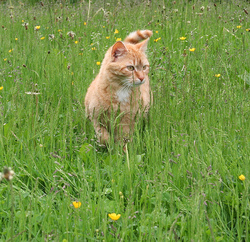Despite growing environmental demands on the part of pets, reducing their carbon footprint is possible

Cats impact the environment, too.
flickr photo by Alexandre Dulanoy
With so many more people taking on the responsibility of sharing life with companion animals — and in many cases multiple pets — the demands on our fair planet are growing at a rate that is faster than ever. The expanding need to use land to grow food, to raise livestock for food and our appetite for energy of all kinds is due in part to, yes, our much smaller furry friends, like dogs and cats.
What's unclear is whether or not the environment can keep up. Can it?
Even though pets depend on the Earth to provide the same things to survive that we do, as humans, we bear the responsibility to minimize that load. There's a lot of talk on reducing the strain on the planet from a human perspective, but have you thought about how you can reduce your pet's carbon footprint? It's possible, and here are a few tips:
Keep it nutritious
Check the ingredient list on your pets' food. How's the quality? A protein-based ingredient like chicken, beef or lamb should be first on the list in the pet food, not a byproduct or chicken/beef/lamb meal. More nutrient-rich, these also promote better health and produce less waste.
Minimize
Many pet-food companies are moving toward using minimal packaging or using renewable resources for their products; look for those (but be sure to save those pet food bags and containers!).
Presentation matters
When choosing dishes for your dogs and cats, forget the plastic. Go with ceramic or stainless steel. Easy to clean, and cats actually prefer them.
Materials count
Have you looked at the choices in your favorite pet store lately? Look closely; you might see toys (especially tug, rope and stuffed toys) constructed out of renewable materials. Hemp is an incredibly durable renewable material that's becoming increasingly more popular. Bamboo, on the other hand, is softer and makes great plush toys that are durable and quick-drying. Both are non-toxic. Some bedding is even being made out of bamboo and hemp.
Groom green
The pet care industry has grown, and do-it-yourself grooming products are a big part of that. A sector that as grown in popularity is the eco-friendly, organic and naturally based pet shampoos, detanglers and other products. They are safer for pets and the planet.
Haste makes waste
All dog owners do their share of picking up poop, right? Today, there are a lot of more choices to help dispose of it more mindfully, with biodegradeable waste bags. Available online from companies like PoopBags.com or BioBag USA (the latter made from corn) at pet stores, they can always be available when conveniently clipped to a dog leash with a small dispenser.
Cat owners are all too aware of the amount of cat litter (usually clay-based) that is used each year to stock litter boxes. All of the scooped waste and spent litter ends up in landfills, so that aspect is an obvious concern.
Fortunately there are greener alternatives in that area, too. Feline Pine is a popular choice, as well as Swheat Scoop (which, as the name suggests, is derived from wheat) are made of plant materials and are more quickly biodegradable than their mineral counterparts. Yesterday's News from the Purina company offers an alternative by using recycled newspaper in their products.
Two of the most far-reaching ways to "go green" are the most practical, as well. No one can deny there are far too many homeless pets. That is of major consequence to the stress put on the planet.
Adopt, don't shop
With the thousands of puppies and kittens born each year, the simple choice of adopting a homeless pet (from the Humane Society of Huron Valley, for example), can make an impact on the environment in the most practical sense. Making a choice to adopt from a shelter or rescue, rather than buying from a breeder, is a simple step in the right direction because companion animals who are already on the planet will be cared for. Plus, the number of pets who are euthanized can be reduced. With so many breeds and mixed breeds to choose from, there is a pet for everyone who is ready to welcome one into their family.
Spay and neuter
The number of dogs and cats who are homeless and abandoned is not decreasing by any means; just take note of the number of animal rescues and shelters you see. It only makes good sense to do the one thing that can help reduce the overall impact on the planet: humanely reduce the number of animals that are born in the first place.
Choosing to spay and neuter when a pet is at an appropriate age and phase of development is a mindful choice that has an alternate effect: healthier pets long term. For female dogs, protection from serious health issues like mammary cancer and uterine infections. For males, a lower risk of prostate disease and testicular cancer.
Lorrie Shaw is lead pets blogger for AnnArbor.com. Catch her daily dog walking and pet sitting adventures or email her directly.


Comments
Jose Luis
Thu, Apr 26, 2012 : 12:23 a.m.
There is also other companies such http://www.dogpoopbags.us that are bringing new products to the poop market.
Lorrie Shaw
Sun, Nov 6, 2011 : 12:54 a.m.
Thanks, LA - and thanks for reading!
LA
Fri, Nov 4, 2011 : 3:40 p.m.
excellent article! thank you